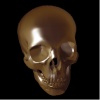Physically based spectral path tracer written in C++, still largely a work in progress but quite functional as illustrated above. The image features physically correct Fresnel-weighted refractions and reflections as well as diffuse interreflection ("color bleeding").
This path tracer uses an optimized bounding volume hierarchy to accelerate ray tracing, allowing it to support scenes well into the tens of millions of objects with only a logarithmic performance hit. Another feature is the easy integration of scalable multithreading, thanks to OpenMP.
The code is available for free at github under the MIT license.
Feedback and/or contributions are very welcome!
Click here to view the iotd
Lambda Spectral Path Tracer
being spectral, I suppose it support dispersion ? it would be great if you'd put a screenshot of a prism or diamond exhibiting this feature. Any plan to port it to GPU ? (cuda, openCL or direct compute)
Hello, thanks guys  the render time for this one was 12h34m5s, mainly because of the amount of glass involved (the BRDF's aren't very optimized as of now). Those without glass take a more reasonable 2-4 hours to render.
the render time for this one was 12h34m5s, mainly because of the amount of glass involved (the BRDF's aren't very optimized as of now). Those without glass take a more reasonable 2-4 hours to render.
But that's with unidirectional path tracing, I predict I will need much less samples when I get around to implementing bidirectional path tracing.
Florent, indeed the tracer supports dispersion, however, dispersion is only visible with very small light sources (otherwise dispersion occurs all over the place and the result is a net white), which standard path tracing has trouble sampling. However I really want to do such an image as soon as BDPT is up.
As for GPU support, it would be difficult, mainly because of the amount of abstraction in the code which doesn't map well to GPU. I think it would be doable in CUDA because of all the extra features, however I don't have an nVidia graphics card. An interesting idea to keep in mind though.
I added a new render (the previous, low-resolution version took 2h27m49s)
But that's with unidirectional path tracing, I predict I will need much less samples when I get around to implementing bidirectional path tracing.
Florent, indeed the tracer supports dispersion, however, dispersion is only visible with very small light sources (otherwise dispersion occurs all over the place and the result is a net white), which standard path tracing has trouble sampling. However I really want to do such an image as soon as BDPT is up.
As for GPU support, it would be difficult, mainly because of the amount of abstraction in the code which doesn't map well to GPU. I think it would be doable in CUDA because of all the extra features, however I don't have an nVidia graphics card. An interesting idea to keep in mind though.
I added a new render (the previous, low-resolution version took 2h27m49s)
This topic is closed to new replies.
Advertisement
Popular Topics
Advertisement








